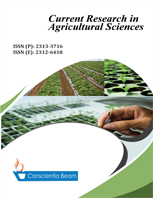Evaluation of Some Cowpea (Vigna Unguiculata L. [Walp]) Genotypes for Stability Of Performance Over 4 Years
DOI:
https://doi.org/10.18488/journal.68/2015.2.1/68.1.22.30Abstract
Genotype × environment interaction (GEI) plays a significant role in determining the desirability or superiority of a genotype, hence the need to evaluate genotypes over wide range of environment. Seven improved cowpea genotypes were evaluated in four environments (years); the late seasons of 2009, 2010. 2011 and 2012 to determine their desirability based on mean grain yield and stability in Abeokuta South-western Nigeria using the Genotype+Genotype×environment (GGE) biplot. IT98K-573-2-1 had the highest mean grain yield while IFE-98-12 had the lowest. There was highly significant Genotype × Environment Interaction on seed yield (p<0.001) indicating the need for GEI analysis. The GGE biplot identified three mega-environments viz AB10 and AB11 as mega-environment 1, AB09 as the mega-environment 2 and AB12 as the third. IT98K-573-2-1, IT04K-333-2 and IT04K-227-4 were the most responsive genotypes in mega-environments 1, 2 and 3 respectively. IT04K-227-4, IT04K-333-2, IT98K-573-1-1and IT98K-573-2-1 were identified to have performed above average while IT99K-1060, LDP10-OBR1 and IFE-98-12 yielded below average. LDP10-OBR1 was the most stable genotype but was low yielding. IT98K-573-2-1 was selected as the best combiner of high yield and stability and the most desirable for Abeokuta South-western Nigeria. AB10 was identified as the best among the test environments.

